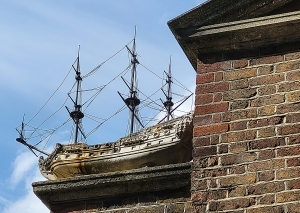What a relief after watching Barbie
AFTER WATCHING THE film “Barbie”, which I did not enjoy and even bored me at times, we walked west from the Genesis Cinema along Mile End Road towards Whitechapel Underground station. On our way, we passed Trinity Green, which is surrounded by the picturesque Trinity Green Almshouses (‘TGA’).

Probably the second oldest surviving almshouses in London, the TGA was built in 1695 by the Corporation of Trinity House. The oldest is The Charterhouse. The purpose of the TGA was to provide housing for poor captains and ship’s masters, and/or their widows. In about 1895, the TGA was threatened with demolition, but saved by a public campaign to preserve them. The buildings were the first to be placed on a preservation register, the forerunner of the ‘listed buildings’ system that protects historic structures from alteration or demolition.
Buildings that flank the two sides of the entrance gate are adorned with sculptures of sailing vessels, complete with masts and rigging. On each of the gatehouses, there are plaques recording the fact that the TGA was built in 1695 on land donated by Henry Mudd of Rattcliff and his widowed sister-in-law. At the end of the rectangular lawn that is surrounded by the dwelling units, there is a chapel, Sadly, the compound was locked up and could only be viewed from the street. It appears that people are still living there.
Seeing the beautiful, nay elegant, TGA was a great relief after having subjected ourselves (voluntarily) to a film, chock full of unsubtle sophomoric (‘sixth or even fifth form’) messages, which many of our intelligent friends have enjoyed greatly. Maybe, we missed something that endeared the film to them. The one good thing I have to say about the film is that I am certain that its box office takings will help keep cinemas we like, including Genesis, in business after the disastrous years of the pandemic.



